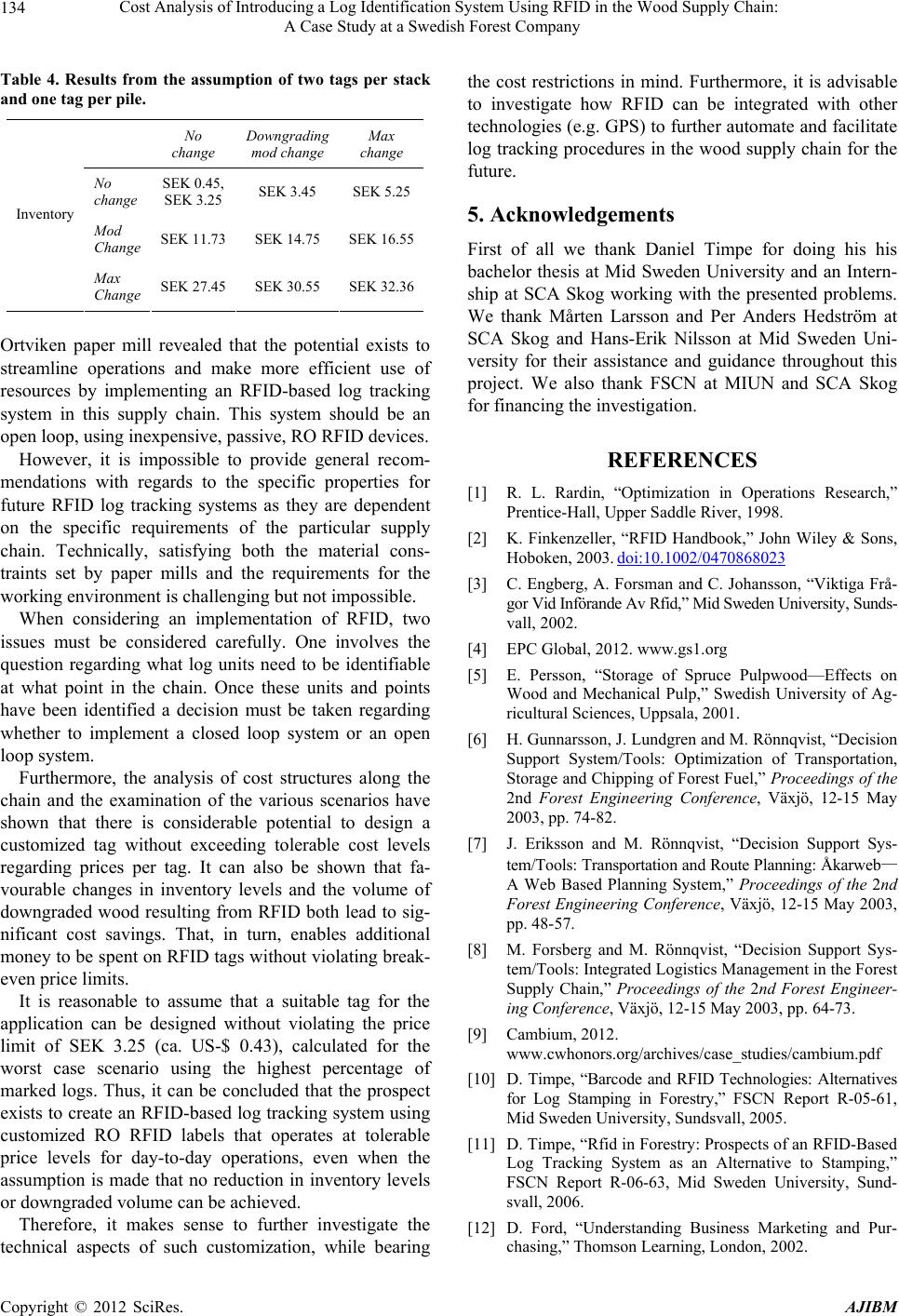
Cost Analysis of Introducing a Log Identification System Using RFID in the Wood Supply Chain:
A Case Study at a Swedish Forest Company
134
Table 4. Results from the assumption of two tags per stack
and one tag per pile.
No
change Downgrading
mod change Max
change
No
change SEK 0.45,
SEK 3.25SEK 3.45 SEK 5.25
Mod
Change SEK 11.73SEK 14.75 SEK 16.55
Inventory
Max
Change SEK 27.45SEK 30.55 SEK 32.36
Ortviken paper mill revealed that the potential exists to
streamline operations and make more efficient use of
resources by implementing an RFID-based log tracking
system in this supply chain. This system should be an
open loop, using inexpensive, passive, RO RFID devices.
However, it is impossible to provide general recom-
mendations with regards to the specific properties for
future RFID log tracking systems as they are dependent
on the specific requirements of the particular supply
chain. Technically, satisfying both the material cons-
traints set by paper mills and the requirements for the
working environment is challenging but not impossible.
When considering an implementation of RFID, two
issues must be considered carefully. One involves the
question regarding what log units need to be identifiable
at what point in the chain. Once these units and points
have been identified a decision must be taken regarding
whether to implement a closed loop system or an open
loop system.
Furthermore, the analysis of cost structures along the
chain and the examination of the various scenarios have
shown that there is considerable potential to design a
customized tag without exceeding tolerable cost levels
regarding prices per tag. It can also be shown that fa-
vourable changes in inventory levels and the volume of
downgraded wood resulting from RFID both lead to sig-
nificant cost savings. That, in turn, enables additional
money to be spent on RFID tags without violating break-
even price limits.
It is reasonable to assume that a suitable tag for the
application can be designed without violating the price
limit of SEK 3.25 (ca. US-$ 0.43), calculated for the
worst case scenario using the highest percentage of
marked logs. Thus, it can be concluded that the prospect
exists to create an RFID-based log tracking system using
customized RO RFID labels that operates at tolerable
price levels for day-to-day operations, even when the
assumption is made that no reduction in inventory levels
or downgraded volume can be achieved.
Therefore, it makes sense to further investigate the
technical aspects of such customization, while bearing
the cost restrictions in mind. Furthermore, it is advisable
to investigate how RFID can be integrated with other
technologies (e.g. GPS) to further au tomate and facilitate
log tracking procedures in the wood supply chain for the
future.
5. Acknowledgements
First of all we thank Daniel Timpe for doing his his
bachelor thesis at Mid Sweden University and an Intern-
ship at SCA Skog working with the presented problems.
We thank Mårten Larsson and Per Anders Hedström at
SCA Skog and Hans-Erik Nilsson at Mid Sweden Uni-
versity for their assistance and guidance throughout this
project. We also thank FSCN at MIUN and SCA Skog
for financing the investigation.
REFERENCES
[1] R. L. Rardin, “Optimization in Operations Research,”
Prentice-Hall, Upper Saddle River, 1998.
[2] K. Finkenzeller, “RFID Handbook,” John Wiley & Sons,
Hoboken, 2003. doi:10.1002/0470868023
[3] C. Engberg, A. Forsman and C. Johansson, “Viktiga Frå-
gor Vid Införande Av Rfid,” Mid Swed en University, Sunds-
vall, 2002.
[4] EPC Global, 2012. www.gs1.org
[5] E. Persson, “Storage of Spruce Pulpwood—Effects on
Wood and Mechanical Pulp,” Swedish University of Ag-
ricultural Sciences, Uppsala, 2001.
[6] H. Gunnarsson, J. Lundgren and M. Rönnqvist, “Decision
Support System/Tools: Optimization of Transportation,
Storage and Chipping of Forest Fuel,” Proceedings of the
2nd Forest Engineering Conference, Växjö, 12-15 May
2003, pp. 74-82.
[7] J. Eriksson and M. Rönnqvist, “Decision Support Sys-
tem/Tools: Transportation and Ro ute Planning: Åk arweb—
A Web Based Planning System,” Proceedings of the 2nd
Forest Engineering Conference, Växjö, 12-15 May 2003,
pp. 48-57.
[8] M. Forsberg and M. Rönnqvist, “Decision Support Sys-
tem/Tools: Integrated Logistics Management in the Forest
Supply Chain,” Proceedings of the 2nd Forest Engineer-
ing Conference, Växjö, 12-15 May 2003, pp. 64-73.
[9] Cambium, 2012.
www.cwhonors.org/archives/case_studies/cambium.pdf
[10] D. Timpe, “Barcode and RFID Technologies: Alternatives
for Log Stamping in Forestry,” FSCN Report R-05-61,
Mid Sweden University, Sundsvall, 2005.
[11] D. Timpe, “Rfid in Forestry: Prospects of an RFID-Based
Log Tracking System as an Alternative to Stamping,”
FSCN Report R-06-63, Mid Sweden University, Sund-
svall, 2006.
[12] D. Ford, “Understanding Business Marketing and Pur-
chasing,” Thomson Learning, London, 2002.
Copyright © 2012 SciRes. AJIBM